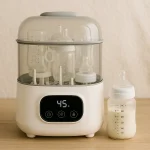- 100 Best Energy Drink Ultimate 2025 Guide - 08/16/2025
- Twisted Tea: The Ultimate 2025 Guide(Kept up to date) - 08/13/2025
- 100 Best Eat & Drink Ultimate 2025 Global List - 08/11/2025

Table of Contents
Swaddle is an age-old technique used to help babies feel secure and sleep more soundly. It involves wrapping a baby snugly in a blanket, mimicking the warmth and coziness of the womb. This guide will walk you through the steps of swaddling a baby safely and effectively, along with tips for ensuring your baby’s comfort and safety.
1. Gather Your Materials
Before you begin swaddling, make sure you have everything you need:
- Swaddling blanket: A thin, breathable blanket works best. Muslin blankets are popular because they are soft and lightweight.
- A flat surface: Use a flat, safe surface like a changing table, bed, or the floor.
2. Understand the Benefits and Risks of Swaddling
Swaddling can offer several benefits, including:
- Promoting sleep: The snugness of a swaddle can prevent the Moro reflex (startle reflex) from waking the baby.
- Providing comfort: Swaddling can mimic the feeling of being in the womb, which is soothing for newborns.
- Reducing anxiety: Swaddling can help calm a fussy baby.
However, it’s important to be aware of the risks:
- Overheating: Using too many layers or swaddling too tightly can cause the baby to overheat.
- Hip dysplasia: Swaddling too tightly around the legs can lead to hip issues. Make sure the baby’s legs have room to move.
- Rolling over: Once a baby starts showing signs of rolling over, swaddling should be stopped to prevent the risk of suffocation.
3. Step-by-Step Guide to Swaddling
Now, let’s go through the process of swaddling step by step:
Step 1: Lay Out the Blanket
Start by spreading the blanket out flat on your chosen surface in a diamond shape, with one corner pointing up. Fold the top corner down about 6 inches to create a straight edge. This fold will go at the baby’s shoulders.
Step 2: Position the Baby
Gently place your baby on their back, with their shoulders aligned with the folded top edge of the blanket. The baby’s head should be above the edge of the blanket, while their body is on the blanket.
Step 3: Wrap the First Side
Take the left corner of the blanket and bring it across the baby’s body, tucking it under their right arm and around their back. Make sure the blanket is snug, but not too tight, around the chest. The baby’s left arm should be straight down by their side, or slightly bent.
Step 4: Wrap the Bottom
Next, bring the bottom corner of the blanket up over the baby’s feet and tuck it behind their shoulder. This ensures the baby’s legs are covered but not restricted. Their legs should have enough room to move and bend naturally to avoid hip issues.
Step 5: Wrap the Second Side
Take the right corner of the blanket and bring it across the baby’s body, over their left arm, and tuck it securely under their back on the left side. The baby should now be snugly swaddled with only their head and neck exposed.
4. Safety Tips for Swaddling
- Check the fit: The swaddle should be snug around the baby’s chest but loose around the hips. You should be able to fit two or three fingers between the swaddle and the baby’s chest.
- Monitor temperature: Ensure the baby isn’t overheating by checking their neck and ears. If they feel hot or sweaty, remove a layer or use a lighter blanket.
- Use the swaddle only for sleep: Swaddling is meant for sleep time only. During wakeful periods, allow the baby to move freely to develop their motor skills.
- Stop swaddling at the right time: Once your baby shows signs of trying to roll over, it’s time to transition away from swaddling to prevent any risk of suffocation.
5. When to Stop Swaddling
It’s generally recommended to stop swaddling around 2-3 months of age, or when the baby begins to show signs of rolling over. At this stage, transition to a sleep sack or wearable blanket that allows free movement while keeping the baby warm.

Conclusion
Swaddling is a wonderful technique to help soothe and comfort a newborn, but it’s crucial to do it safely. By following the steps outlined above and keeping safety tips in mind, you can help your baby sleep more peacefully while reducing the risks associated with swaddling. Always observe your baby’s reactions and adjust the swaddle as necessary to ensure their comfort and well-being.
Best Baby And Nursery Services(7 Types) – love a happy home (loveahh.com)
- Kudos Diapers: 2025 In-Depth Guide for Parents
- Rascal And Friends Diapers: 2025 In-Depth Parent’s Guide
- Millie Moon Diapers: In-Depth 2025 Parent Guide
- Coterie Diapers: The In-Depth 2025 Guide
- Baby Bottle Washer and Sterilizer 2025(In-Depth)
- How to Bottle Feed a Baby 2025(In-Depth)
- Easy Baby Names(5 Types Perfect Choice)
- Best Baby Names(5 Types Perfect Choice)
- How To Swaddle A Baby(5 Steps Very Detailed)
- Best Baby And Nursery Services(7 Types)
🎯 Don’t Miss Out — These Are Reader-Favorite Bestsellers You’ll Love Too 👇
| # | 🎁 Product | 💬 Why It Converts | 🔗 Quick Action |
|---|---|---|---|
| ✅ 1 | Exploding KittensThe Wildly Popular Card Game | 🔥 100,000+ rave reviews🤣 Fun for all ages🎉 #1 party game choice | 👉 Click to Check Price |
| 😂 2 | Funny Dad T-Shirt“You Can’t Scare Me, I Have Kids” | 👕 Viral dad gift🎂 Perfect for birthdays & Father’s Day💬 Gets people laughing instantly | 👉 See It in Action |
| 🕯️ 3 | Luxury Candle Gift SetElegant 1-Wick, Spa Fragrance | 🧘♀️ Instant relaxation🎁 Beautifully boxed for gifting💡 Affordable luxury | 👉 Treat Yourself or Gift Now |
| 🔍 4 | Tile Bluetooth TrackerFind Anything in Seconds | 🛠️ Life-saving tech🧓 Great for parents, teens, travelers📱 Works with your phone | 👉 Never Lose Anything Again |
| 📘 5 | Atomic Habits by James ClearTransform Your Daily Life | 📖 20M+ readers worldwide🔑 Simple steps, big results🎓 Top self-growth book | 👉 Read What Everyone’s Talking About |
✅ Why These Items Sell:
| 💡 Trigger | Example in Table | How It Helps Conversion |
|---|---|---|
| ✅ Social Proof | “100,000+ rave reviews” | Builds trust instantly |
| 🎯 Use Case Clarity | “Great for family game night” | Reduces decision friction |
| 🚀 Action Verbs | “Click to check price” | Encourages immediate action |
| 🔥 Urgency & Emotion | “Don’t miss out” / “Treat yourself” | Triggers impulse buying |
| 🎁 Gifting Potential | “Perfect for birthdays & holidays” | Taps into universal purchase intent |
❤️ Your Click Makes a Difference
Every purchase made through these links helps support this site and keeps great content coming — Thanks!
💬 Why Tip? It’s Not Just Money — It’s Motivation ❤️
| 😊 What You Got | 🎁 What I Get | 🔗 What You Can Do |
|---|---|---|
| ✔️ A smile or laugh | ✔️ A reason to keep creating | 👉 Buy me a coffee ☕️ |
| ✔️ Useful tips, insights, or ideas | ✔️ Proof that this content helps | 👉 Click the support button 💸 |
| ✔️ Fun, relatable content | ✔️ Motivation to go deeper & better | 👉 Leave a tip + kind feedback 🙌 |
| ✔️ Ad-free reading experience | ✔️ A little financial breathing room | 👉 $1 isn’t too little, $10 isn’t too much 🎉 |
| ✔️ A sense of connection | ✔️ The joy of being seen and supported | 👉 Let me know you’re out there 👀 |
❤️ If you made it this far, maybe that’s your sign to support? Every tip matters!











